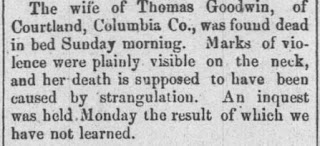The theme for Week 16 is "Should Be a Movie." What is family history without the stories? (It's a bunch of cold, lonely facts, that's what!) What story in your family should be up on the silver screen? Write about it this week! Click here to check out all the themes for 2023.
Thomas E Goodwin, my 1st cousin 3x removed (my paternal grandmother’s side) first married Catherine McMahon (possibly my 1st cousin 3x removed on my paternal grandfather’s side) on Oct 26, 1881. They had two children. Catherine died Nov 1, 1885. She was found dead in bed with marks of violence were plainly visible on the neck, and her death is supposed to have been caused by strangulation.
An inquest was held and the verdict of the coroner’s jury was that the death was from natural causes.
Thomas E Goodwin then married Mary Biel on May 29, 1890. They had five children born between 1891 and 1899. Thomas was a saloon keeper. On their 10th wedding anniversary, Thomas came home intoxicated. Mary helped him to bed. About a half an hour later, he came into her room where she lay asleep. He told her that a horse was sick in the barn and that he wished her to hold the lantern while he attended to the animal. However, when they were near the old well, he grabbed her and after a struggle, threw her into the well. Mary was in the well most of the night and nearly died from fright and exposure. Mary’s screams brought help and she was removed from the well by her brother, Lewis Biel and several others.
During the trial, it was mentioned that Thomas had tried to commit his wife, Mary to an insane asylum a few weeks before the alleged attempt to murder her. Also, Thomas tired to show that his wife, if not insane, was in a highly disturbed and hysterical mental condition and had either wandered to the region of the well and fallen in or had attempted suicide. The trail also shown that the couple had domestic troubles.
On Nov, 21, 1900, Mary Goodwin was granted a divorce by Judge Dick and awarded a $2000 alimony.
In Dec 1901, Thomas was sentenced to five years in Waupun State Penitentiary by the same Judge Dick that awarded the divorce between Mary and Thomas.
Thomas took the appeal to the Supreme Court and in the meantime, was released on bail.
Even though the case was tried in Janesville, Wisconsin, in Oct 1902, he was found guilty a second time. Unfortunately, for Thomas, this time he was sentenced to ten years.
In Dec 1907, Governor Davidson paroled Thomas on the recommendation of the state board of control, having served only five years of his sentence. A new law was in place that required a prisoner before being paroled, must have served one half of the full term and have guaranteed employment for at least one year. Plus, a monthly report must be made on the conduct and condition of the paroled prisoner.
Mary died on July 24, 1921 and Thomas died Dec 26, 1927. Thomas and his first wife are buried together in Lost Lake, Dodge County, Wisconsin while Mary is buried in Beaver Dam, Dodge County, Wisconsin.
This story sounds like a movie to me. I wonder who would play, Thomas, Catherine, and Mary.
Remember to have fun and Just do Genealogy!





Wow, those poor women!
ReplyDeleteWell told, Charlene! I find your family story fascinating on its own, but also because I have one like it (and need to write it up!) about a family member in 19th century Wisconsin who killed his wife and himself after an argument about potatoes. Both stories are examples of many from the rural winter wastelands that Robert Goolrick writes about in his grim novel, "The Reliable Wife." He talks about it in an interview with NPR back in 2009:
ReplyDelete'"Wisconsin Death Trip" was published 35 years ago. It's by a man named Michael Lesy. It's a collection of photographs and newspaper accounts of the life of a small town in Wisconsin, Black River Falls in 1896. The pictures are of ordinary everyday people. The accounts are in general about people going crazy, people going into states of religious fanaticism, drowning their children, burning their barns, killing their animals. The town was a hotbed of craziness. And here they were locked in the middle of nowhere. We always had this notion that pastoral life at the end of the 19th century was calm and beautiful and serene. And Lesy says it wasn't that way at all."
Thanks for your contribution, telling these uneasy tales!